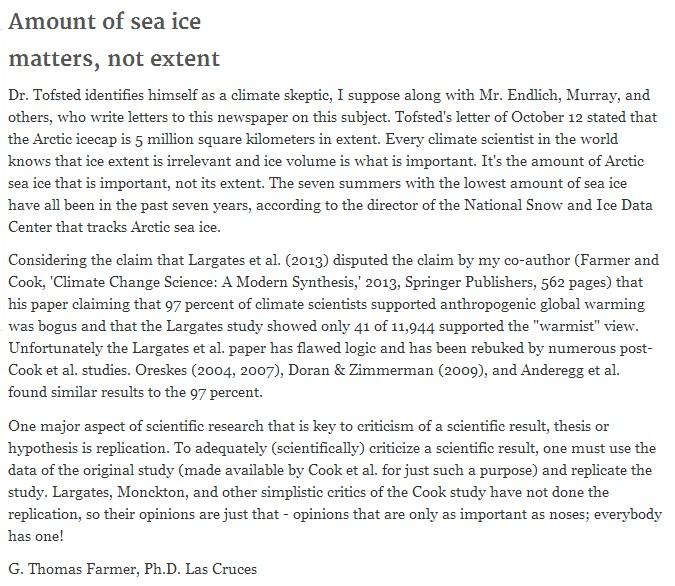Disrupting the Borg is expensive and time consuming!
Google Search
-
Recent Posts
- “Earlier Than Usual”
- Perfect Correlation
- Elon’s Hockey Stick
- Latest Climate News
- “Climate dread is everywhere”
- “The Atmosphere Is ‘Thirstier.’”
- Skynet Becomes Self Aware
- “We Have To Vote For It So That You Can See What’s In It”
- Diversity Is Our Strength
- “even within the lifetime of our children”
- 60 Years Of Progress in London
- The Anti-Greta
- “a persistent concern”
- Deadliest US Tornado Days
- The Other Side Of The Pond
- “HEMI V8 Roars Back”
- Big Pharma Sales Tool
- Your Tax Dollars At Work
- 622 billion tons of new ice
- Fossil Fuels To Turn The UK Tropical
- 100% Tariffs On Chinese EV’s
- Fossil Fuels Cause Fungus
- Prophets Of Doom
- The Green New Deal Lives On
- Mission Accomplished!
Recent Comments
- GW on “Earlier Than Usual”
- Francis Barnett on “even within the lifetime of our children”
- conrad ziefle on “Earlier Than Usual”
- Gordon Vigurs on “Earlier Than Usual”
- Bob G on “Earlier Than Usual”
- MLH on “Earlier Than Usual”
- Gordon Vigurs on Perfect Correlation
- Jack the Insider on “Earlier Than Usual”
- Bob G on “Earlier Than Usual”
- John Francis on “Earlier Than Usual”
PhD Boldly Goes Where Kooks And Nutters Have Gone Before
This entry was posted in Uncategorized. Bookmark the permalink.



Ice extent maybe irrelevant, and ice volume more important, except that extent can actually be measured, and volume can only be modeled.
And modeling is darn near useless when it comes to accurately measuring anything. GIGO
Actually,extent is more important because it affects the Earth’s radiative balance.
At least that was the argument several years ago.
How can a study published in 2013 be “rebuked” by studies from earlier years? 2004, 2007, 2009 as alleged by Farmer? Why it must be the AGW crowd at work again.
The same way temperatures from eighty years ago can change.
Extent does not matter UNLESS it’s September 2012 or 2007. 🙂 Remember the headlines?
This “Dr” G. Thomas Farmer is so interested in the ideas sceptics develop about his work that he doesn’t even bother checking their name. As far as I know, Dr David Legates is not called Largates by anybody but “Dr” G. Thomas Farmer. And if reproducing and precisely recomputating the flawed logic that produced the Cook et al 97% consensus is the only way “Dr” Farmer understands critical checking, then it is easy to see why “Dr” Farmer is on the warmists’ side. He is as stupid and crooked as they are.
Anybody mentioning “Doran & Zimmermann” in support of the 97% myth, is an obvious fraud who has not read Doran & Zimmermann.
Exactly right. http://tinyurl.com/Clim97pct
G. Thomas Farmer, PhD: http://www.amazon.com/G.-Thomas-Farmer/e/B005FQXZ4W
The one comment back at Dr. Farmer, from the Las Cruces Sun;
I’m fascinated by the fact that this 97% figure keeps recurring in the warmist literature (much like the repeated demonstration of a hockey-stick temperature graph). Even though the figure originally applied only to climatologists (as I recall only 82% of the respondents overall answered yes to the two relevant questions in the first study that came up with this figure). It’s pretty clear that they’re trying to justify the earlier figure by coming up with the same number in another study, even though the population is now quite different, so that getting the same number really makes no sense. Another case of DDS – Dummies Doing Science.
So the take home from this is that noses aren’t important? Why doesn’t this guy then cut off his nose to lower his carbon footprint?
-Scott
Oh crap, I remember now. I actually saw somewhere this summer (a comment at Neven’s I think) where the new metric for them isn’t even volume–it’s average thickness. So even though volume was (supposedly) up this summer, he/she was claiming this year was the worst condition of the Arctic ice because average thickness was (supposedly) a record low.
That’d be like claiming that the Arctic ice in April is worse than it is in September because April has, on average, a thinner ice pack (because of all the short-lived ice at the periphery).
-Scott